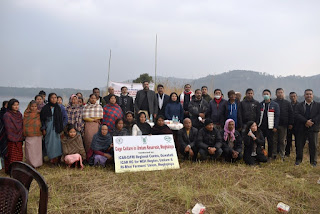Meghalaya (Fisheries) on ‘Prospects of cage culture in Meghalaya’ held at cage culture site in Umiam reservoir
ICAR-Central Inland Fisheries Research Institute, Regional Centre, Guwahati in collaboration with ICAR
Research Complex for NEH Region, Umiam is carrying out cage culture trial in Umiam reservoir through
participation of tribal (khasi) farmers (including women) of locality under the Ri-Bhoi Farmers’ Union for
assessing the techno-economic feasibility of cage culture technology, which is the first of its kind in the
NE hilly state. The information on the success of the cage culture has been reported by several local
newspapers of Meghalaya and Assam including several websites. Mr. S.P. Ahammed, IAS, Principal
Secretary to Govt. of Meghalaya (Fisheries) has expressed his interest to visit cage culture site. Mr.
Ahammed visited the cage culture site in Umiam reservoir on February 3, 2022 along with the Smt. A.L.
Mawlong, MCS, Director (Fisheries); Mr. Paul Tariang, Superintendent of Fisheries, Ri-Bhoi district and
other fisheries officials of Meghalaya. On this occasion, an Interactive meeting on Prospects of cage
culture in Meghalaya’ was organized at the cage culture site in Umiam reservoir at Umniuh Khwan
village. The programme was organized under the overall guidance of Dr. B. K. Das, Director, ICAR-
CIFRI, Barrackpore; Dr. V. K. Mishra, Director, ICAR RC for NEHR, Umiam and Coordinated by Dr. B.
K. Bhattacharjya, Head (Acting), ICAR-CIFRI RC, Guwahati as well as Dr. S. K. Das, Principal Scientist
& Head (In-charge), Fisheries Unit, ICAR RC for NEH Region, Umiam. Scientists and technical
personnel of the two ICAR Institutes viz., Dr. S. Yengkokpam (Sr. Scientist), Dr. Pronob Das, Dr. S.
Borah, Mr. T. Tayung (Scientists), Mr. A. Das (TO) and Mr. P. Mahanta (STA) as well as Mr. A.K.
Borah, I/c NFDB NE Centre, Guwahati participated in the interactive programme. The programme was
attended by the local tribal fishers and farmers (including 18 women) of locality under Ri-Bhoi Farmers’
Union along with Mr. D. Majaw, President of the Union and the local Village Headman. Representatives
from local media were also present in the interactive programme.
Dr. S. K. Das welcomed the guests and participants for the programme and explained the purpose of the
day-long programme. He informed the participants that cage culture in Umiam reservoir of Meghalaya
being carried out since 2019 by ICAR-CIFRI Regional Centre, Guwahati and the ICAR RC for NEHR,
Umiam with support from Ri-Bhoi Farmers’ Union. He stated that it was possible because of the guidance
of Dr. J. K. Jena, DDG (Fisheries), ICAR, New Delhi and initiative of Dr. B. K. Das, Director, ICAR-
CIFRI, Barrackpore. Dr. B.K. Bhattacharjya mentioned that both ICAR institutes worked together for
refining the cage culture technology developed by ICAR-CIFRI to assess techno-economic feasibility of
cage culture under mid-altitude conditions. He briefed about the outcome of the three cage culture trials
conducted in the reservoir. He also highlighted the cage culture activities being carried out by ICAR-
CIFRI in different parts of India with special emphasis on Northeast India. He also informed that ICAR-
CIFRI has commercialized CIFRI-GI cage, CIFRI-HDPE pen and CIFRI-CAGEGROW feed for
openwaters. Smt. A.L. Mawlong thanked both the ICAR Institutes for their effort for development of cage
culture including openwaters in the state. Mr. Paul Tariang explained the deliberations to the local fishers
in Khasi. Mr. D. Majaw thanked both ICAR the Institute and DDG (Fisheries), ICAR, New Delhi for
initiating cage culture in the reservoir for the benefit of the local community and gave feedback about the
programme.
During the interaction, the Principal Secretary and the Director (Fisheries), Meghalaya interacted with the
Scientists of both the ICAR Institutes, representative of NFDB and beneficiaries of cage culture on
different aspects. After deliberations, the Principal Secretary requested both the ICAR Institutes to carry
out studies on other possible uses of the reservoir for higher livelihood support and technological support
for large scale adoption of cage culture in the state.









.jpeg)

No comments: